Lack of Medical Resources in Rural Areas: Challenges and Solutions
VerifiedAdded on 2023/06/10
|12
|3024
|275
AI Summary
This article discusses the challenges faced by rural areas due to lack of medical resources and suggests ways to address the issue. Nurses can play a crucial role in reducing the barriers to access medical facilities in rural areas. The essay highlights the need for government and non-governmental organizations to work together to improve primary health care services, establish telemedicine, and provide incentives to nurse practitioners to serve in rural areas. The article also emphasizes the importance of community support centers, health promotion programs, and strict health-related guidelines for patients in rural areas.
Contribute Materials
Your contribution can guide someone’s learning journey. Share your
documents today.
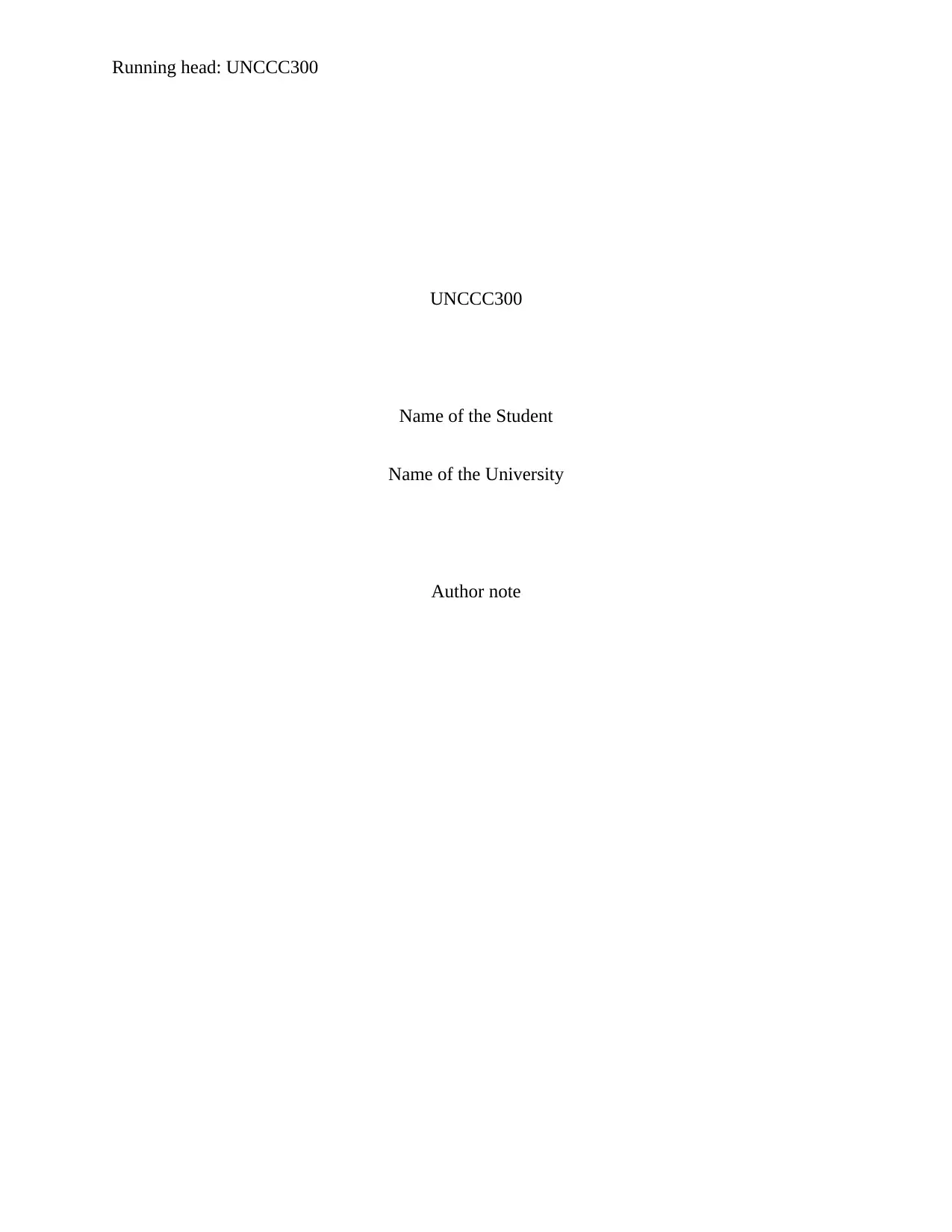
Running head: UNCCC300
UNCCC300
Name of the Student
Name of the University
Author note
UNCCC300
Name of the Student
Name of the University
Author note
Secure Best Marks with AI Grader
Need help grading? Try our AI Grader for instant feedback on your assignments.

1UNCCC300
Assessment 2
Open editorial- Lack of medical resources in rural areas
Australian health care has significantly improved in the last decade. However, the people
living in remote and rural areas are suffering more often with illness. The gap in the health care
is attributed to the lack of medical resources in the rural areas.
People in rural areas wait longer to see doctors, when compared to urban city
counterparts. As per the reports from the Council of Australian Governments reform council,
there is less incentives given to the medical specialists to move to the rural areas. In rural areas
there are only 135 doctors per 100,000, in compared to the 335 in the urban cities (Wakerman et
al., 2017).
People in rural areas have high prevalence of chronic diseases and they lack access to the
primary health care services such as general practioners who can treat patents on emergency
conditions. In addition to shortage of physicians, other healthcare professionals, other factors for
lack of medical resources are geographical barriers. There are less number of health care
facilities in rural areas and often provided limited services. It is because of extreme weather
conditions, and poor transportation. It increases the response time by the emergency medical
professionals as well as ambulatory services (Wakerman et al., 2017).
Economists and the investors mainly invest in the health care sectors in urban areas as it
is not highly profitable in rural areas. Therefore, there are primary health care services without
the lab technicians and pharmacists. On the other hand people in rural areas prefer to be treated
in the local environment, especially the Indigenous community. In addition, there is lack of
adequate funding and infrastructure to support the medical facilities in rural areas. Rural people
Assessment 2
Open editorial- Lack of medical resources in rural areas
Australian health care has significantly improved in the last decade. However, the people
living in remote and rural areas are suffering more often with illness. The gap in the health care
is attributed to the lack of medical resources in the rural areas.
People in rural areas wait longer to see doctors, when compared to urban city
counterparts. As per the reports from the Council of Australian Governments reform council,
there is less incentives given to the medical specialists to move to the rural areas. In rural areas
there are only 135 doctors per 100,000, in compared to the 335 in the urban cities (Wakerman et
al., 2017).
People in rural areas have high prevalence of chronic diseases and they lack access to the
primary health care services such as general practioners who can treat patents on emergency
conditions. In addition to shortage of physicians, other healthcare professionals, other factors for
lack of medical resources are geographical barriers. There are less number of health care
facilities in rural areas and often provided limited services. It is because of extreme weather
conditions, and poor transportation. It increases the response time by the emergency medical
professionals as well as ambulatory services (Wakerman et al., 2017).
Economists and the investors mainly invest in the health care sectors in urban areas as it
is not highly profitable in rural areas. Therefore, there are primary health care services without
the lab technicians and pharmacists. On the other hand people in rural areas prefer to be treated
in the local environment, especially the Indigenous community. In addition, there is lack of
adequate funding and infrastructure to support the medical facilities in rural areas. Rural people
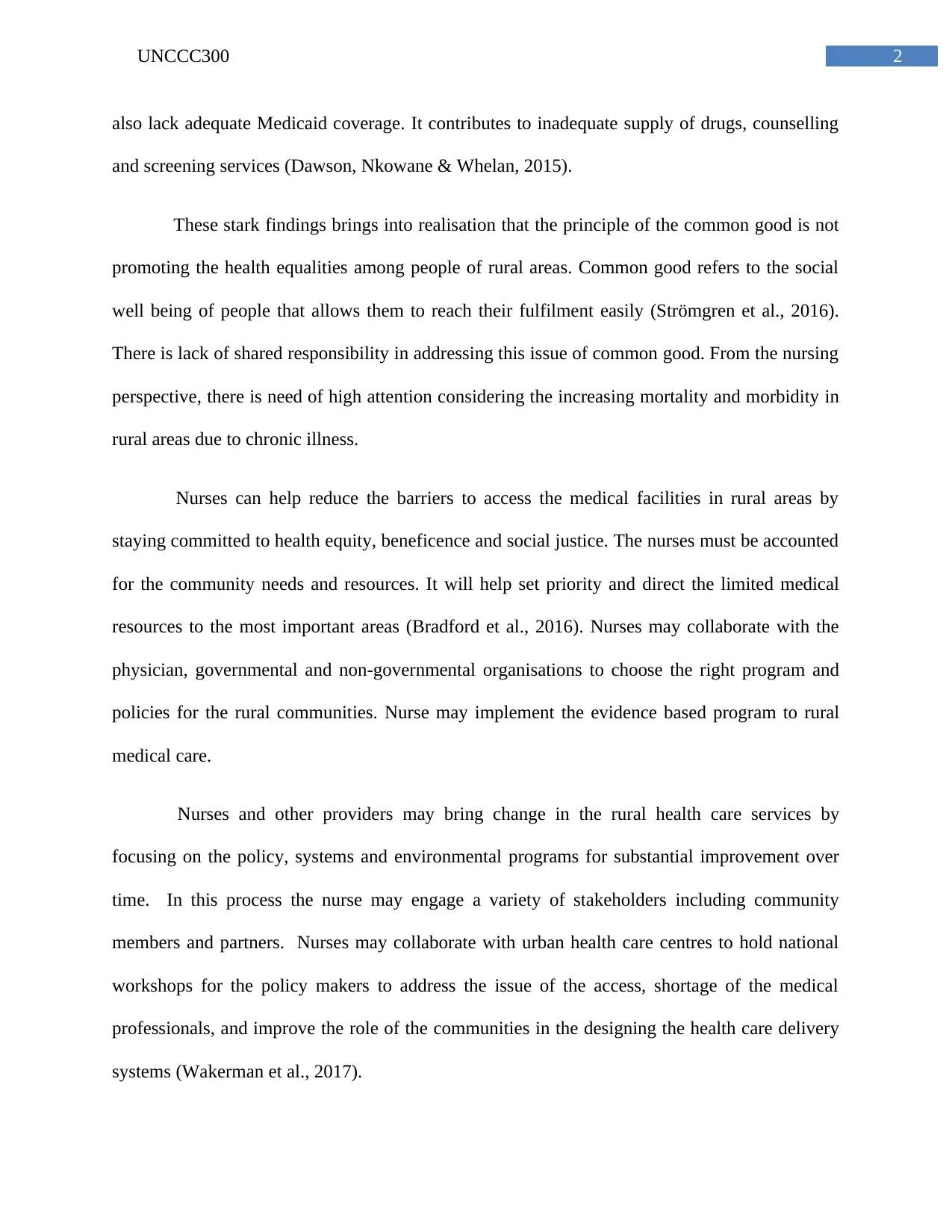
2UNCCC300
also lack adequate Medicaid coverage. It contributes to inadequate supply of drugs, counselling
and screening services (Dawson, Nkowane & Whelan, 2015).
These stark findings brings into realisation that the principle of the common good is not
promoting the health equalities among people of rural areas. Common good refers to the social
well being of people that allows them to reach their fulfilment easily (Strömgren et al., 2016).
There is lack of shared responsibility in addressing this issue of common good. From the nursing
perspective, there is need of high attention considering the increasing mortality and morbidity in
rural areas due to chronic illness.
Nurses can help reduce the barriers to access the medical facilities in rural areas by
staying committed to health equity, beneficence and social justice. The nurses must be accounted
for the community needs and resources. It will help set priority and direct the limited medical
resources to the most important areas (Bradford et al., 2016). Nurses may collaborate with the
physician, governmental and non-governmental organisations to choose the right program and
policies for the rural communities. Nurse may implement the evidence based program to rural
medical care.
Nurses and other providers may bring change in the rural health care services by
focusing on the policy, systems and environmental programs for substantial improvement over
time. In this process the nurse may engage a variety of stakeholders including community
members and partners. Nurses may collaborate with urban health care centres to hold national
workshops for the policy makers to address the issue of the access, shortage of the medical
professionals, and improve the role of the communities in the designing the health care delivery
systems (Wakerman et al., 2017).
also lack adequate Medicaid coverage. It contributes to inadequate supply of drugs, counselling
and screening services (Dawson, Nkowane & Whelan, 2015).
These stark findings brings into realisation that the principle of the common good is not
promoting the health equalities among people of rural areas. Common good refers to the social
well being of people that allows them to reach their fulfilment easily (Strömgren et al., 2016).
There is lack of shared responsibility in addressing this issue of common good. From the nursing
perspective, there is need of high attention considering the increasing mortality and morbidity in
rural areas due to chronic illness.
Nurses can help reduce the barriers to access the medical facilities in rural areas by
staying committed to health equity, beneficence and social justice. The nurses must be accounted
for the community needs and resources. It will help set priority and direct the limited medical
resources to the most important areas (Bradford et al., 2016). Nurses may collaborate with the
physician, governmental and non-governmental organisations to choose the right program and
policies for the rural communities. Nurse may implement the evidence based program to rural
medical care.
Nurses and other providers may bring change in the rural health care services by
focusing on the policy, systems and environmental programs for substantial improvement over
time. In this process the nurse may engage a variety of stakeholders including community
members and partners. Nurses may collaborate with urban health care centres to hold national
workshops for the policy makers to address the issue of the access, shortage of the medical
professionals, and improve the role of the communities in the designing the health care delivery
systems (Wakerman et al., 2017).
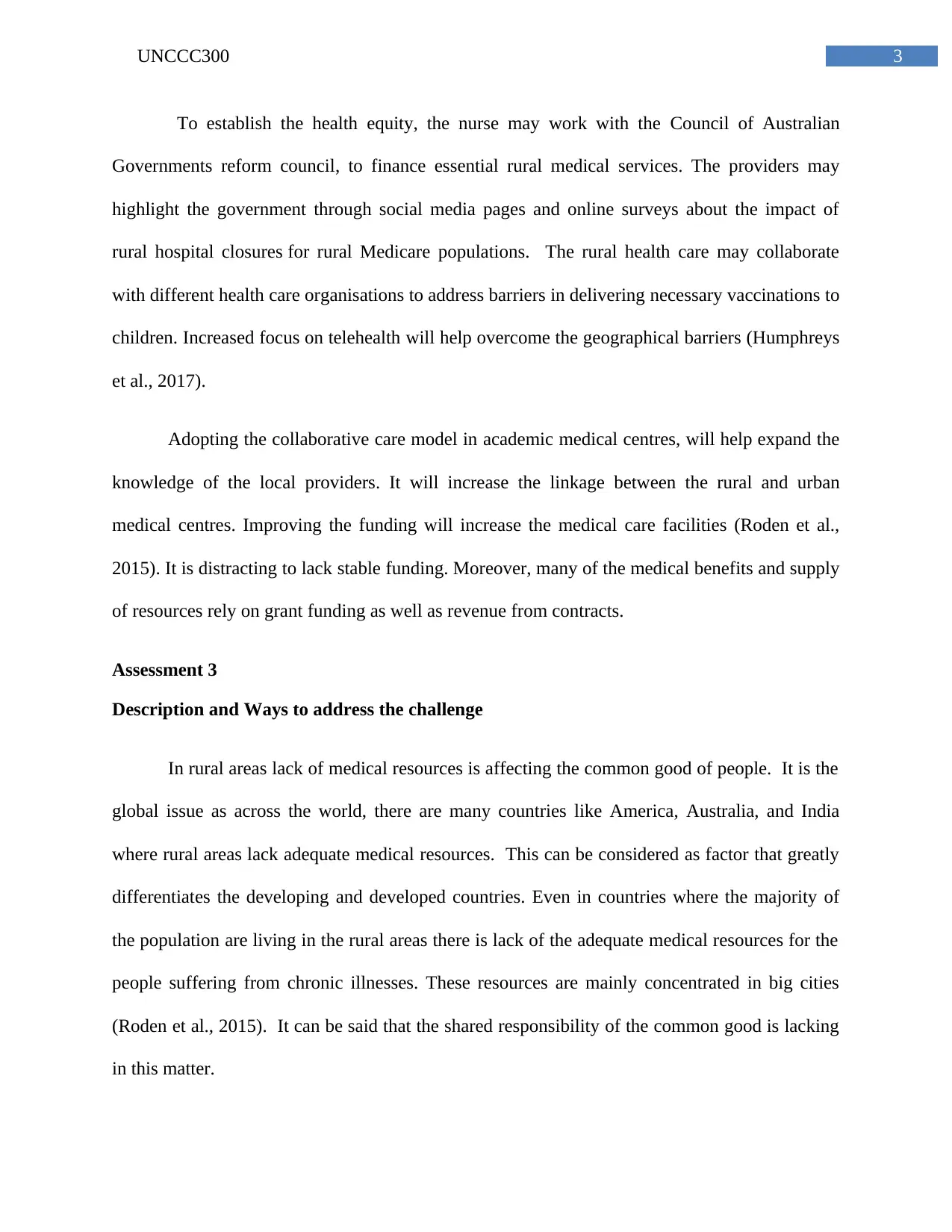
3UNCCC300
To establish the health equity, the nurse may work with the Council of Australian
Governments reform council, to finance essential rural medical services. The providers may
highlight the government through social media pages and online surveys about the impact of
rural hospital closures for rural Medicare populations. The rural health care may collaborate
with different health care organisations to address barriers in delivering necessary vaccinations to
children. Increased focus on telehealth will help overcome the geographical barriers (Humphreys
et al., 2017).
Adopting the collaborative care model in academic medical centres, will help expand the
knowledge of the local providers. It will increase the linkage between the rural and urban
medical centres. Improving the funding will increase the medical care facilities (Roden et al.,
2015). It is distracting to lack stable funding. Moreover, many of the medical benefits and supply
of resources rely on grant funding as well as revenue from contracts.
Assessment 3
Description and Ways to address the challenge
In rural areas lack of medical resources is affecting the common good of people. It is the
global issue as across the world, there are many countries like America, Australia, and India
where rural areas lack adequate medical resources. This can be considered as factor that greatly
differentiates the developing and developed countries. Even in countries where the majority of
the population are living in the rural areas there is lack of the adequate medical resources for the
people suffering from chronic illnesses. These resources are mainly concentrated in big cities
(Roden et al., 2015). It can be said that the shared responsibility of the common good is lacking
in this matter.
To establish the health equity, the nurse may work with the Council of Australian
Governments reform council, to finance essential rural medical services. The providers may
highlight the government through social media pages and online surveys about the impact of
rural hospital closures for rural Medicare populations. The rural health care may collaborate
with different health care organisations to address barriers in delivering necessary vaccinations to
children. Increased focus on telehealth will help overcome the geographical barriers (Humphreys
et al., 2017).
Adopting the collaborative care model in academic medical centres, will help expand the
knowledge of the local providers. It will increase the linkage between the rural and urban
medical centres. Improving the funding will increase the medical care facilities (Roden et al.,
2015). It is distracting to lack stable funding. Moreover, many of the medical benefits and supply
of resources rely on grant funding as well as revenue from contracts.
Assessment 3
Description and Ways to address the challenge
In rural areas lack of medical resources is affecting the common good of people. It is the
global issue as across the world, there are many countries like America, Australia, and India
where rural areas lack adequate medical resources. This can be considered as factor that greatly
differentiates the developing and developed countries. Even in countries where the majority of
the population are living in the rural areas there is lack of the adequate medical resources for the
people suffering from chronic illnesses. These resources are mainly concentrated in big cities
(Roden et al., 2015). It can be said that the shared responsibility of the common good is lacking
in this matter.
Secure Best Marks with AI Grader
Need help grading? Try our AI Grader for instant feedback on your assignments.
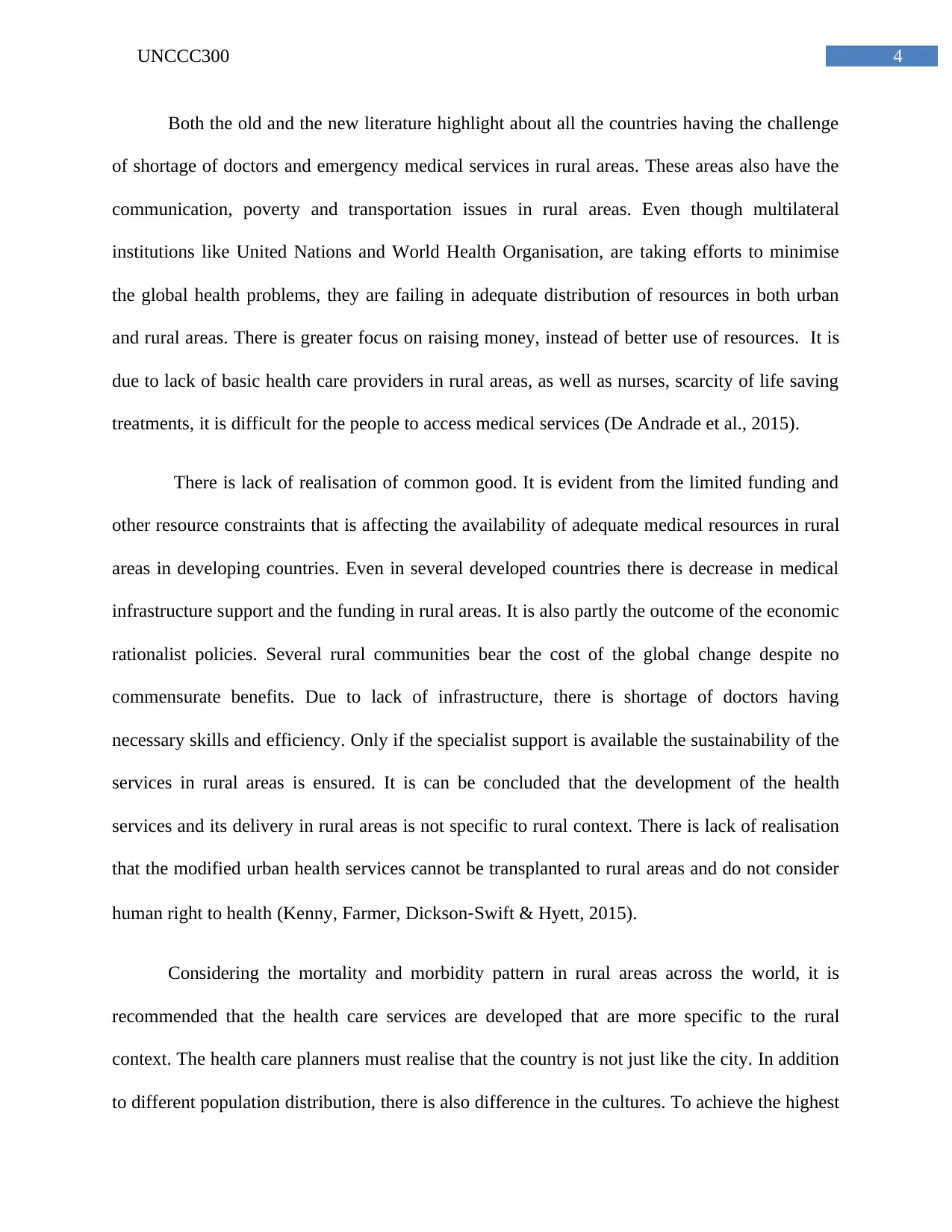
4UNCCC300
Both the old and the new literature highlight about all the countries having the challenge
of shortage of doctors and emergency medical services in rural areas. These areas also have the
communication, poverty and transportation issues in rural areas. Even though multilateral
institutions like United Nations and World Health Organisation, are taking efforts to minimise
the global health problems, they are failing in adequate distribution of resources in both urban
and rural areas. There is greater focus on raising money, instead of better use of resources. It is
due to lack of basic health care providers in rural areas, as well as nurses, scarcity of life saving
treatments, it is difficult for the people to access medical services (De Andrade et al., 2015).
There is lack of realisation of common good. It is evident from the limited funding and
other resource constraints that is affecting the availability of adequate medical resources in rural
areas in developing countries. Even in several developed countries there is decrease in medical
infrastructure support and the funding in rural areas. It is also partly the outcome of the economic
rationalist policies. Several rural communities bear the cost of the global change despite no
commensurate benefits. Due to lack of infrastructure, there is shortage of doctors having
necessary skills and efficiency. Only if the specialist support is available the sustainability of the
services in rural areas is ensured. It is can be concluded that the development of the health
services and its delivery in rural areas is not specific to rural context. There is lack of realisation
that the modified urban health services cannot be transplanted to rural areas and do not consider
human right to health (Kenny, Farmer, Dickson‐Swift & Hyett, 2015).
Considering the mortality and morbidity pattern in rural areas across the world, it is
recommended that the health care services are developed that are more specific to the rural
context. The health care planners must realise that the country is not just like the city. In addition
to different population distribution, there is also difference in the cultures. To achieve the highest
Both the old and the new literature highlight about all the countries having the challenge
of shortage of doctors and emergency medical services in rural areas. These areas also have the
communication, poverty and transportation issues in rural areas. Even though multilateral
institutions like United Nations and World Health Organisation, are taking efforts to minimise
the global health problems, they are failing in adequate distribution of resources in both urban
and rural areas. There is greater focus on raising money, instead of better use of resources. It is
due to lack of basic health care providers in rural areas, as well as nurses, scarcity of life saving
treatments, it is difficult for the people to access medical services (De Andrade et al., 2015).
There is lack of realisation of common good. It is evident from the limited funding and
other resource constraints that is affecting the availability of adequate medical resources in rural
areas in developing countries. Even in several developed countries there is decrease in medical
infrastructure support and the funding in rural areas. It is also partly the outcome of the economic
rationalist policies. Several rural communities bear the cost of the global change despite no
commensurate benefits. Due to lack of infrastructure, there is shortage of doctors having
necessary skills and efficiency. Only if the specialist support is available the sustainability of the
services in rural areas is ensured. It is can be concluded that the development of the health
services and its delivery in rural areas is not specific to rural context. There is lack of realisation
that the modified urban health services cannot be transplanted to rural areas and do not consider
human right to health (Kenny, Farmer, Dickson‐Swift & Hyett, 2015).
Considering the mortality and morbidity pattern in rural areas across the world, it is
recommended that the health care services are developed that are more specific to the rural
context. The health care planners must realise that the country is not just like the city. In addition
to different population distribution, there is also difference in the cultures. To achieve the highest
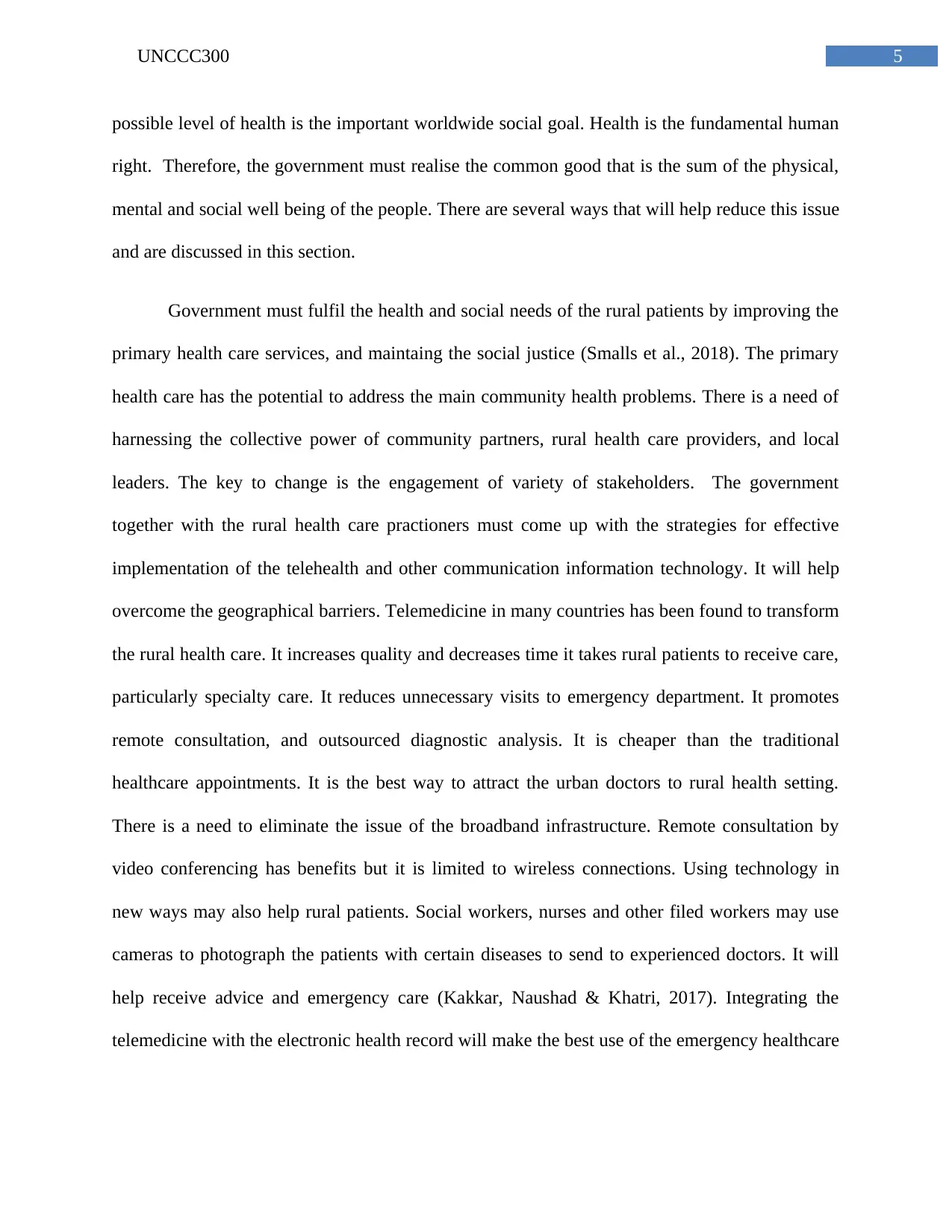
5UNCCC300
possible level of health is the important worldwide social goal. Health is the fundamental human
right. Therefore, the government must realise the common good that is the sum of the physical,
mental and social well being of the people. There are several ways that will help reduce this issue
and are discussed in this section.
Government must fulfil the health and social needs of the rural patients by improving the
primary health care services, and maintaing the social justice (Smalls et al., 2018). The primary
health care has the potential to address the main community health problems. There is a need of
harnessing the collective power of community partners, rural health care providers, and local
leaders. The key to change is the engagement of variety of stakeholders. The government
together with the rural health care practioners must come up with the strategies for effective
implementation of the telehealth and other communication information technology. It will help
overcome the geographical barriers. Telemedicine in many countries has been found to transform
the rural health care. It increases quality and decreases time it takes rural patients to receive care,
particularly specialty care. It reduces unnecessary visits to emergency department. It promotes
remote consultation, and outsourced diagnostic analysis. It is cheaper than the traditional
healthcare appointments. It is the best way to attract the urban doctors to rural health setting.
There is a need to eliminate the issue of the broadband infrastructure. Remote consultation by
video conferencing has benefits but it is limited to wireless connections. Using technology in
new ways may also help rural patients. Social workers, nurses and other filed workers may use
cameras to photograph the patients with certain diseases to send to experienced doctors. It will
help receive advice and emergency care (Kakkar, Naushad & Khatri, 2017). Integrating the
telemedicine with the electronic health record will make the best use of the emergency healthcare
possible level of health is the important worldwide social goal. Health is the fundamental human
right. Therefore, the government must realise the common good that is the sum of the physical,
mental and social well being of the people. There are several ways that will help reduce this issue
and are discussed in this section.
Government must fulfil the health and social needs of the rural patients by improving the
primary health care services, and maintaing the social justice (Smalls et al., 2018). The primary
health care has the potential to address the main community health problems. There is a need of
harnessing the collective power of community partners, rural health care providers, and local
leaders. The key to change is the engagement of variety of stakeholders. The government
together with the rural health care practioners must come up with the strategies for effective
implementation of the telehealth and other communication information technology. It will help
overcome the geographical barriers. Telemedicine in many countries has been found to transform
the rural health care. It increases quality and decreases time it takes rural patients to receive care,
particularly specialty care. It reduces unnecessary visits to emergency department. It promotes
remote consultation, and outsourced diagnostic analysis. It is cheaper than the traditional
healthcare appointments. It is the best way to attract the urban doctors to rural health setting.
There is a need to eliminate the issue of the broadband infrastructure. Remote consultation by
video conferencing has benefits but it is limited to wireless connections. Using technology in
new ways may also help rural patients. Social workers, nurses and other filed workers may use
cameras to photograph the patients with certain diseases to send to experienced doctors. It will
help receive advice and emergency care (Kakkar, Naushad & Khatri, 2017). Integrating the
telemedicine with the electronic health record will make the best use of the emergency healthcare
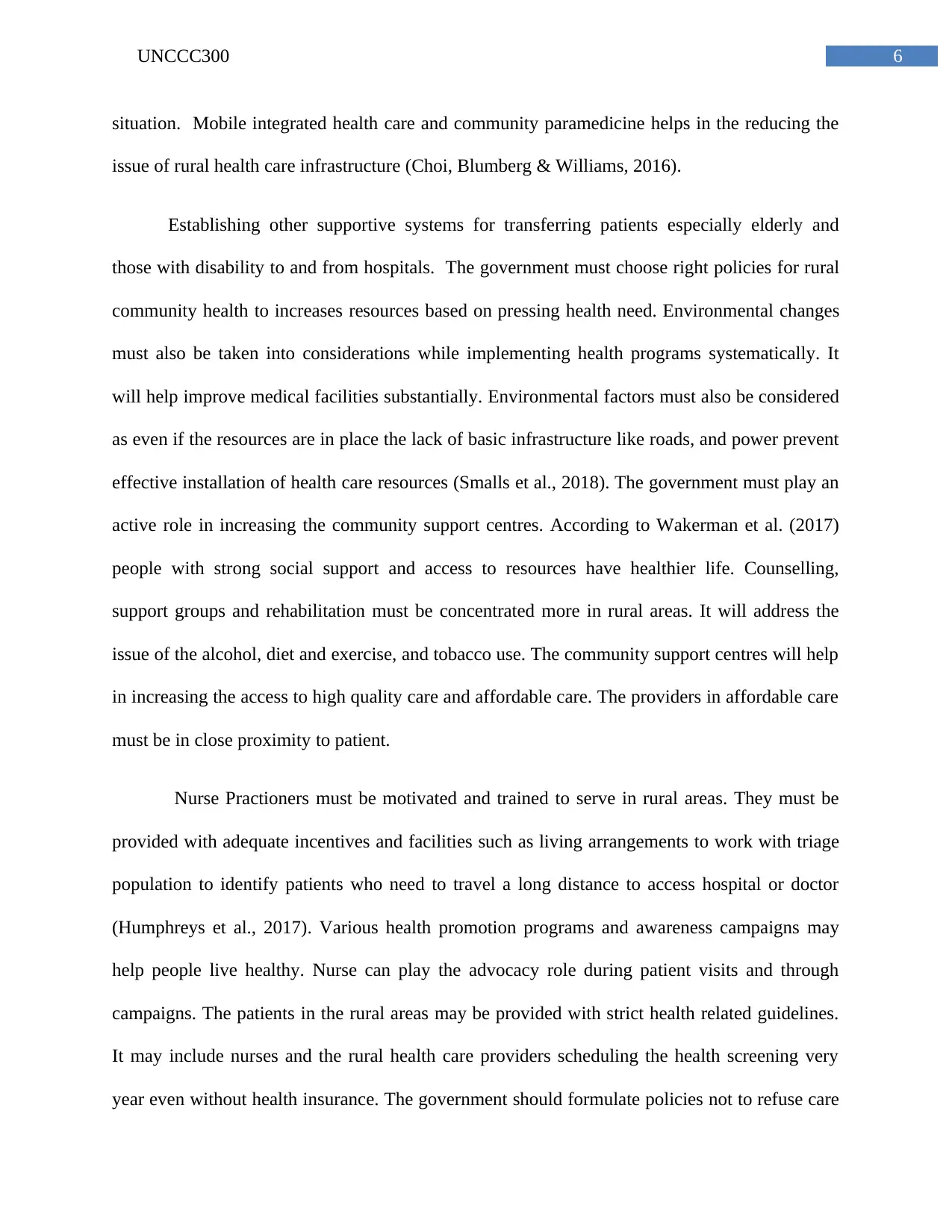
6UNCCC300
situation. Mobile integrated health care and community paramedicine helps in the reducing the
issue of rural health care infrastructure (Choi, Blumberg & Williams, 2016).
Establishing other supportive systems for transferring patients especially elderly and
those with disability to and from hospitals. The government must choose right policies for rural
community health to increases resources based on pressing health need. Environmental changes
must also be taken into considerations while implementing health programs systematically. It
will help improve medical facilities substantially. Environmental factors must also be considered
as even if the resources are in place the lack of basic infrastructure like roads, and power prevent
effective installation of health care resources (Smalls et al., 2018). The government must play an
active role in increasing the community support centres. According to Wakerman et al. (2017)
people with strong social support and access to resources have healthier life. Counselling,
support groups and rehabilitation must be concentrated more in rural areas. It will address the
issue of the alcohol, diet and exercise, and tobacco use. The community support centres will help
in increasing the access to high quality care and affordable care. The providers in affordable care
must be in close proximity to patient.
Nurse Practioners must be motivated and trained to serve in rural areas. They must be
provided with adequate incentives and facilities such as living arrangements to work with triage
population to identify patients who need to travel a long distance to access hospital or doctor
(Humphreys et al., 2017). Various health promotion programs and awareness campaigns may
help people live healthy. Nurse can play the advocacy role during patient visits and through
campaigns. The patients in the rural areas may be provided with strict health related guidelines.
It may include nurses and the rural health care providers scheduling the health screening very
year even without health insurance. The government should formulate policies not to refuse care
situation. Mobile integrated health care and community paramedicine helps in the reducing the
issue of rural health care infrastructure (Choi, Blumberg & Williams, 2016).
Establishing other supportive systems for transferring patients especially elderly and
those with disability to and from hospitals. The government must choose right policies for rural
community health to increases resources based on pressing health need. Environmental changes
must also be taken into considerations while implementing health programs systematically. It
will help improve medical facilities substantially. Environmental factors must also be considered
as even if the resources are in place the lack of basic infrastructure like roads, and power prevent
effective installation of health care resources (Smalls et al., 2018). The government must play an
active role in increasing the community support centres. According to Wakerman et al. (2017)
people with strong social support and access to resources have healthier life. Counselling,
support groups and rehabilitation must be concentrated more in rural areas. It will address the
issue of the alcohol, diet and exercise, and tobacco use. The community support centres will help
in increasing the access to high quality care and affordable care. The providers in affordable care
must be in close proximity to patient.
Nurse Practioners must be motivated and trained to serve in rural areas. They must be
provided with adequate incentives and facilities such as living arrangements to work with triage
population to identify patients who need to travel a long distance to access hospital or doctor
(Humphreys et al., 2017). Various health promotion programs and awareness campaigns may
help people live healthy. Nurse can play the advocacy role during patient visits and through
campaigns. The patients in the rural areas may be provided with strict health related guidelines.
It may include nurses and the rural health care providers scheduling the health screening very
year even without health insurance. The government should formulate policies not to refuse care
Paraphrase This Document
Need a fresh take? Get an instant paraphrase of this document with our AI Paraphraser
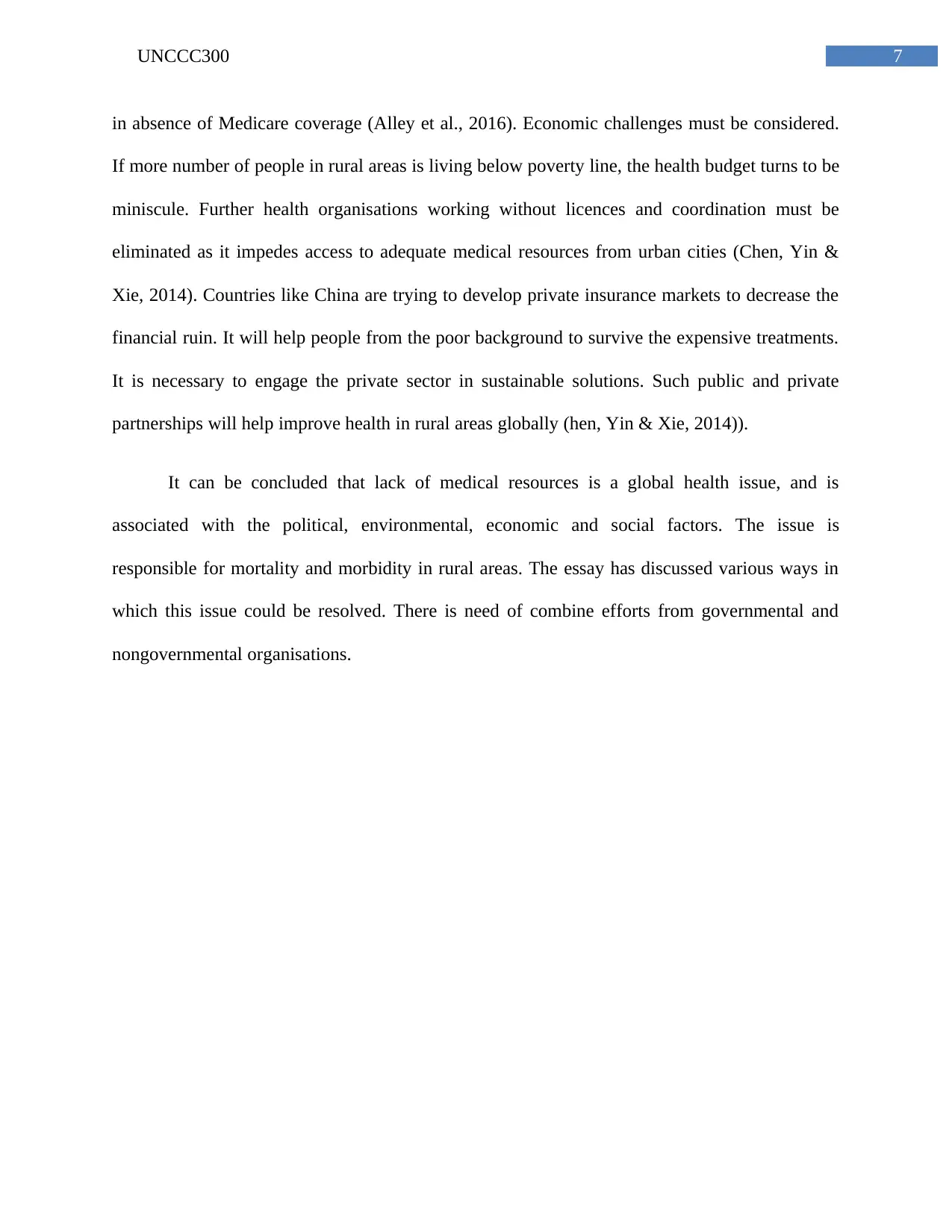
7UNCCC300
in absence of Medicare coverage (Alley et al., 2016). Economic challenges must be considered.
If more number of people in rural areas is living below poverty line, the health budget turns to be
miniscule. Further health organisations working without licences and coordination must be
eliminated as it impedes access to adequate medical resources from urban cities (Chen, Yin &
Xie, 2014). Countries like China are trying to develop private insurance markets to decrease the
financial ruin. It will help people from the poor background to survive the expensive treatments.
It is necessary to engage the private sector in sustainable solutions. Such public and private
partnerships will help improve health in rural areas globally (hen, Yin & Xie, 2014)).
It can be concluded that lack of medical resources is a global health issue, and is
associated with the political, environmental, economic and social factors. The issue is
responsible for mortality and morbidity in rural areas. The essay has discussed various ways in
which this issue could be resolved. There is need of combine efforts from governmental and
nongovernmental organisations.
in absence of Medicare coverage (Alley et al., 2016). Economic challenges must be considered.
If more number of people in rural areas is living below poverty line, the health budget turns to be
miniscule. Further health organisations working without licences and coordination must be
eliminated as it impedes access to adequate medical resources from urban cities (Chen, Yin &
Xie, 2014). Countries like China are trying to develop private insurance markets to decrease the
financial ruin. It will help people from the poor background to survive the expensive treatments.
It is necessary to engage the private sector in sustainable solutions. Such public and private
partnerships will help improve health in rural areas globally (hen, Yin & Xie, 2014)).
It can be concluded that lack of medical resources is a global health issue, and is
associated with the political, environmental, economic and social factors. The issue is
responsible for mortality and morbidity in rural areas. The essay has discussed various ways in
which this issue could be resolved. There is need of combine efforts from governmental and
nongovernmental organisations.

8UNCCC300
References
All, A. C., Fried, J. H., & Wallace, D. C. (2017). Quality of life, chronic pain, and issues for
healthcare professionals in rural communities. Online Journal of Rural Nursing and
Health Care, 1(2), 29-57.
Alley, D. E., Asomugha, C. N., Conway, P. H., & Sanghavi, D. M. (2016). Accountable health
communities—addressing social needs through Medicare and Medicaid. N Engl J
Med, 374(1), 8-11.
Bradford, N. K., Caffery, L. J., & Smith, A. C. (2016). Telehealth services in rural and remote
Australia: a systematic review of models of care and factors influencing success and
sustainability. Rural and remote health, 16(3808).
Chen, Y., Yin, Z., & Xie, Q. (2014). Suggestions to ameliorate the inequity in urban/rural
allocation of healthcare resources in China. International journal for equity in
health, 13(1), 34.
Choi, B. Y., Blumberg, C., & Williams, K. (2016). Mobile integrated health care and community
paramedicine: an emerging emergency medical services concept. Annals of emergency
medicine, 67(3), 361-366.
Dawson, A. J., Nkowane, A. M., & Whelan, A. (2015). Approaches to improving the
contribution of the nursing and midwifery workforce to increasing universal access to
primary health care for vulnerable populations: a systematic review. Human resources for
health, 13(1), 97.
References
All, A. C., Fried, J. H., & Wallace, D. C. (2017). Quality of life, chronic pain, and issues for
healthcare professionals in rural communities. Online Journal of Rural Nursing and
Health Care, 1(2), 29-57.
Alley, D. E., Asomugha, C. N., Conway, P. H., & Sanghavi, D. M. (2016). Accountable health
communities—addressing social needs through Medicare and Medicaid. N Engl J
Med, 374(1), 8-11.
Bradford, N. K., Caffery, L. J., & Smith, A. C. (2016). Telehealth services in rural and remote
Australia: a systematic review of models of care and factors influencing success and
sustainability. Rural and remote health, 16(3808).
Chen, Y., Yin, Z., & Xie, Q. (2014). Suggestions to ameliorate the inequity in urban/rural
allocation of healthcare resources in China. International journal for equity in
health, 13(1), 34.
Choi, B. Y., Blumberg, C., & Williams, K. (2016). Mobile integrated health care and community
paramedicine: an emerging emergency medical services concept. Annals of emergency
medicine, 67(3), 361-366.
Dawson, A. J., Nkowane, A. M., & Whelan, A. (2015). Approaches to improving the
contribution of the nursing and midwifery workforce to increasing universal access to
primary health care for vulnerable populations: a systematic review. Human resources for
health, 13(1), 97.
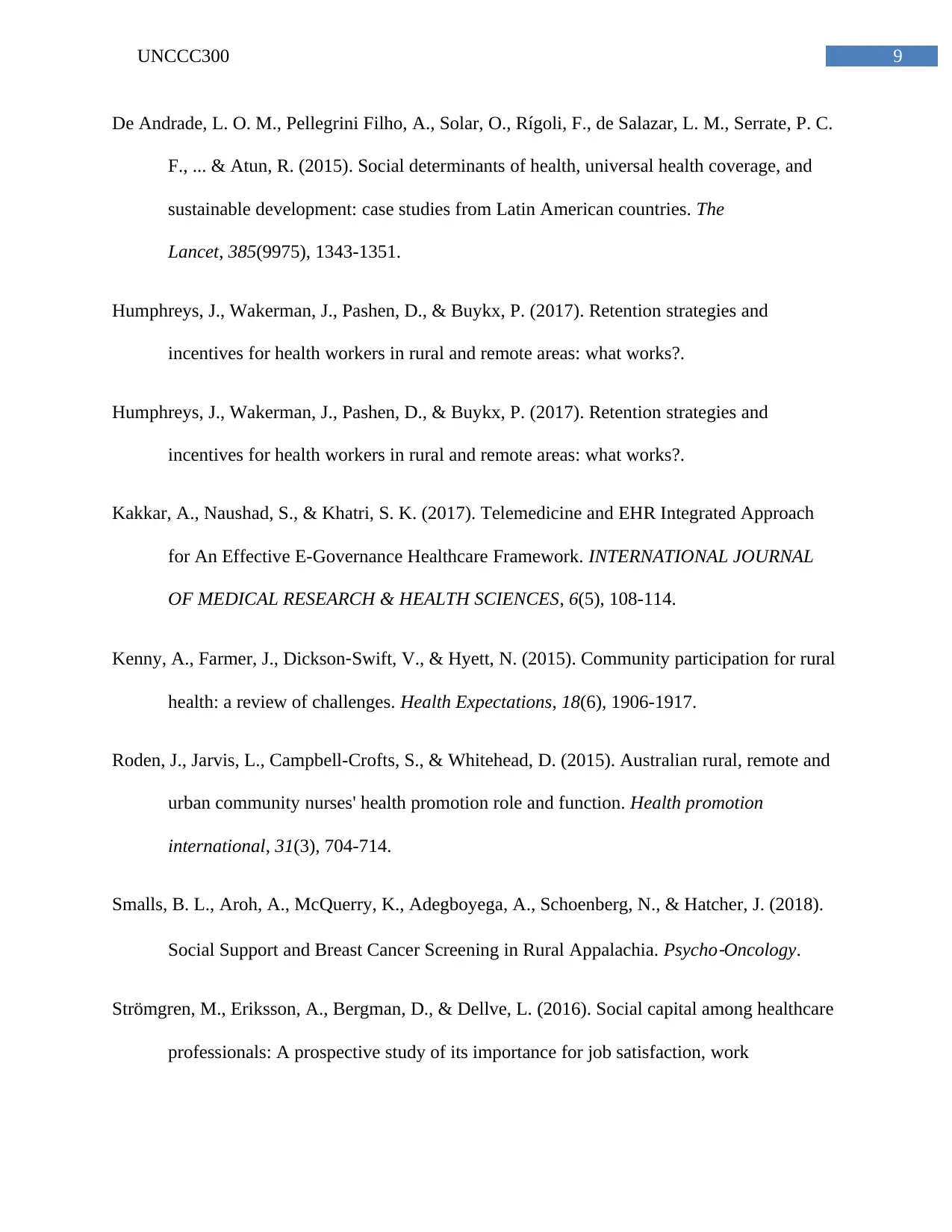
9UNCCC300
De Andrade, L. O. M., Pellegrini Filho, A., Solar, O., Rígoli, F., de Salazar, L. M., Serrate, P. C.
F., ... & Atun, R. (2015). Social determinants of health, universal health coverage, and
sustainable development: case studies from Latin American countries. The
Lancet, 385(9975), 1343-1351.
Humphreys, J., Wakerman, J., Pashen, D., & Buykx, P. (2017). Retention strategies and
incentives for health workers in rural and remote areas: what works?.
Humphreys, J., Wakerman, J., Pashen, D., & Buykx, P. (2017). Retention strategies and
incentives for health workers in rural and remote areas: what works?.
Kakkar, A., Naushad, S., & Khatri, S. K. (2017). Telemedicine and EHR Integrated Approach
for An Effective E-Governance Healthcare Framework. INTERNATIONAL JOURNAL
OF MEDICAL RESEARCH & HEALTH SCIENCES, 6(5), 108-114.
Kenny, A., Farmer, J., Dickson‐Swift, V., & Hyett, N. (2015). Community participation for rural
health: a review of challenges. Health Expectations, 18(6), 1906-1917.
Roden, J., Jarvis, L., Campbell-Crofts, S., & Whitehead, D. (2015). Australian rural, remote and
urban community nurses' health promotion role and function. Health promotion
international, 31(3), 704-714.
Smalls, B. L., Aroh, A., McQuerry, K., Adegboyega, A., Schoenberg, N., & Hatcher, J. (2018).
Social Support and Breast Cancer Screening in Rural Appalachia. Psycho
‐Oncology.
Strömgren, M., Eriksson, A., Bergman, D., & Dellve, L. (2016). Social capital among healthcare
professionals: A prospective study of its importance for job satisfaction, work
De Andrade, L. O. M., Pellegrini Filho, A., Solar, O., Rígoli, F., de Salazar, L. M., Serrate, P. C.
F., ... & Atun, R. (2015). Social determinants of health, universal health coverage, and
sustainable development: case studies from Latin American countries. The
Lancet, 385(9975), 1343-1351.
Humphreys, J., Wakerman, J., Pashen, D., & Buykx, P. (2017). Retention strategies and
incentives for health workers in rural and remote areas: what works?.
Humphreys, J., Wakerman, J., Pashen, D., & Buykx, P. (2017). Retention strategies and
incentives for health workers in rural and remote areas: what works?.
Kakkar, A., Naushad, S., & Khatri, S. K. (2017). Telemedicine and EHR Integrated Approach
for An Effective E-Governance Healthcare Framework. INTERNATIONAL JOURNAL
OF MEDICAL RESEARCH & HEALTH SCIENCES, 6(5), 108-114.
Kenny, A., Farmer, J., Dickson‐Swift, V., & Hyett, N. (2015). Community participation for rural
health: a review of challenges. Health Expectations, 18(6), 1906-1917.
Roden, J., Jarvis, L., Campbell-Crofts, S., & Whitehead, D. (2015). Australian rural, remote and
urban community nurses' health promotion role and function. Health promotion
international, 31(3), 704-714.
Smalls, B. L., Aroh, A., McQuerry, K., Adegboyega, A., Schoenberg, N., & Hatcher, J. (2018).
Social Support and Breast Cancer Screening in Rural Appalachia. Psycho
‐Oncology.
Strömgren, M., Eriksson, A., Bergman, D., & Dellve, L. (2016). Social capital among healthcare
professionals: A prospective study of its importance for job satisfaction, work
Secure Best Marks with AI Grader
Need help grading? Try our AI Grader for instant feedback on your assignments.

10UNCCC300
engagement and engagement in clinical improvements. International Journal of Nursing
Studies, 53, 116-125.
Venkatesh, V., Sykes, T. A., & Venkatraman, S. (2014). Understanding e‐Government portal use
in rural India: role of demographic and personality characteristics. Information Systems
Journal, 24(3), 249-269.
Wakerman, J., Humphreys, J., Wells, R., Kuipers, P., Entwistle, P., & Jones, J. (2017). A
systematic review of primary health care delivery models in rural and remote Australia
1993-2006.
engagement and engagement in clinical improvements. International Journal of Nursing
Studies, 53, 116-125.
Venkatesh, V., Sykes, T. A., & Venkatraman, S. (2014). Understanding e‐Government portal use
in rural India: role of demographic and personality characteristics. Information Systems
Journal, 24(3), 249-269.
Wakerman, J., Humphreys, J., Wells, R., Kuipers, P., Entwistle, P., & Jones, J. (2017). A
systematic review of primary health care delivery models in rural and remote Australia
1993-2006.

11UNCCC300
1 out of 12
Your All-in-One AI-Powered Toolkit for Academic Success.
+13062052269
info@desklib.com
Available 24*7 on WhatsApp / Email
![[object Object]](/_next/static/media/star-bottom.7253800d.svg)
Unlock your academic potential
© 2024 | Zucol Services PVT LTD | All rights reserved.




